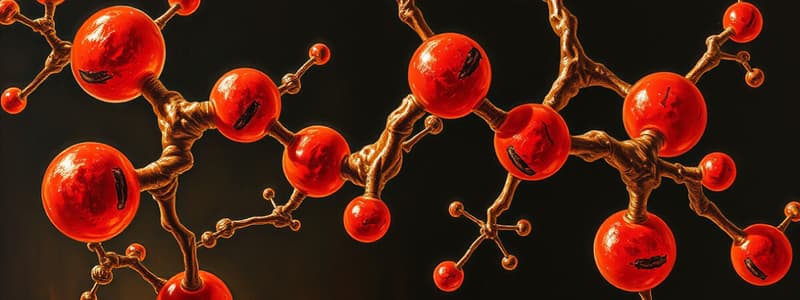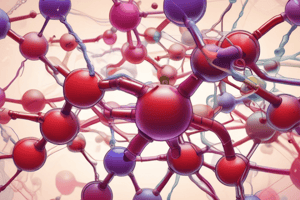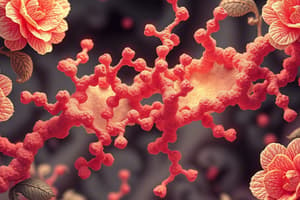Podcast
Questions and Answers
What is the primary consequence of HbS aggregation in sickle cell disease?
What is the primary consequence of HbS aggregation in sickle cell disease?
- Prevention of erythrocyte deformability (correct)
- Stabilization of glutamic acid by hydrogen bonds
- Increased oxygen affinity of hemoglobin
- Formation of excess beta chains in erythrocytes
How does the structure of HbS differ from HbA at the molecular level?
How does the structure of HbS differ from HbA at the molecular level?
- HbS replaces glutamic acid with valine in the sixth position (correct)
- HbS has a higher concentration of alpha-globin chains
- HbS forms dimers instead of polymers
- HbS contains an additional iron atom in its structure
What type of anemia may result from an imbalanced production of globin chains?
What type of anemia may result from an imbalanced production of globin chains?
- Iron deficiency anemia
- Hereditary hemolytic anemia (correct)
- Sickle cell anemia
- Folic acid deficiency anemia
What constitutional feature causes sickle-shaped cells to become trapped in capillaries?
What constitutional feature causes sickle-shaped cells to become trapped in capillaries?
Which condition is characterized by a deficiency of alpha-globin production?
Which condition is characterized by a deficiency of alpha-globin production?
What structural classification does hemoglobin (Hb) belong to?
What structural classification does hemoglobin (Hb) belong to?
What is the key structural change in deoxyHb that initiates the aggregation of HbS?
What is the key structural change in deoxyHb that initiates the aggregation of HbS?
Which of the following statements about myoglobin (Mb) is correct?
Which of the following statements about myoglobin (Mb) is correct?
What is the primary structural feature of globins?
What is the primary structural feature of globins?
What is unique about the haem group in globins?
What is unique about the haem group in globins?
In adult humans, what is the predominant form of hemoglobin present?
In adult humans, what is the predominant form of hemoglobin present?
How many heme groups can each globin molecule bind to oxygen?
How many heme groups can each globin molecule bind to oxygen?
What is the effect of the mutation that causes sickle cell anaemia?
What is the effect of the mutation that causes sickle cell anaemia?
How does HbF differ from HbA in its interaction with BPG?
How does HbF differ from HbA in its interaction with BPG?
What characteristic defines sickle cell trait?
What characteristic defines sickle cell trait?
What is the result of the hydrophobic patches on β-globin caused by the sickle cell mutation?
What is the result of the hydrophobic patches on β-globin caused by the sickle cell mutation?
What role does the mutation of β-globin play in sickle cell disease severity?
What role does the mutation of β-globin play in sickle cell disease severity?
Which of the following statements about HbS is true?
Which of the following statements about HbS is true?
What is the role of the Fe2+ ion in the haem group?
What is the role of the Fe2+ ion in the haem group?
What is the significance of hydrophobic residues in globin?
What is the significance of hydrophobic residues in globin?
Which form of haemoglobin is unable to bind oxygen?
Which form of haemoglobin is unable to bind oxygen?
What characteristic shape does the oxygen saturation curve of haemoglobin exhibit?
What characteristic shape does the oxygen saturation curve of haemoglobin exhibit?
What is allostery in the context of haemoglobin?
What is allostery in the context of haemoglobin?
What ion form is incapable of participating in oxygen binding?
What ion form is incapable of participating in oxygen binding?
Which amino acid residue is specifically mentioned as binding to the Fe2+ ion in the haem group?
Which amino acid residue is specifically mentioned as binding to the Fe2+ ion in the haem group?
What effect does the occupancy of haemoglobin have on its affinity for oxygen?
What effect does the occupancy of haemoglobin have on its affinity for oxygen?
How does a decrease in pH affect the ability of hemoglobin to bind oxygen?
How does a decrease in pH affect the ability of hemoglobin to bind oxygen?
What physiological condition causes an increase in H+ concentration in peripheral tissues?
What physiological condition causes an increase in H+ concentration in peripheral tissues?
At a physiological pH, what is the dissociation status of carbonic acid?
At a physiological pH, what is the dissociation status of carbonic acid?
In the lungs, what effect does high pO2 have on hemoglobin?
In the lungs, what effect does high pO2 have on hemoglobin?
What is the pKa value of deoxyhemoglobin at physiological pH?
What is the pKa value of deoxyhemoglobin at physiological pH?
What process is facilitated by carbonic anhydrase in the context of oxygen transport?
What process is facilitated by carbonic anhydrase in the context of oxygen transport?
Which factor directly contributes to hemoglobin releasing most of its oxygen in peripheral tissues?
Which factor directly contributes to hemoglobin releasing most of its oxygen in peripheral tissues?
How does oxyhemoglobin affect the acidity in erythrocytes?
How does oxyhemoglobin affect the acidity in erythrocytes?
Study Notes
Structure of Hemoglobin (Hb) and Myoglobin (Mb)
- Hemoglobin (Hb) is a tetramer consisting of 2 identical alpha globin and 2 identical beta globin subunits, forming a dimer of dimers (α1β1)(α2β2).
- Myoglobin (Mb) is a monomer and has a similar structure to Hb, with both containing approximately 150 amino acids arranged in alpha helices.
- Each globin has a heme group located in a hydrophobic pocket, with the hydrophilic side facing outward to bind oxygen (O2).
- Each heme group has the ability to bind one oxygen molecule.
Haem Group
- The heme group contains a ferrous iron (Fe2+) ion that can bond with six ligands: four from nitrogen atoms of the heme, one from a histidine in the globin, and one for reversible O2 attachment.
- Hemoglobin exists in two forms: Oxyhemoglobin (oxyHb) and Deoxyhemoglobin (deoxyHb).
- Hydrophobic residues within globins prevent oxidation of Fe2+ to Fe3+, which cannot bind oxygen (methemoglobin, metHb).
Cooperative Oxygen Binding
- Hemoglobin exhibits cooperative binding, with oxygen saturation curves showing a sigmoid shape; affinity for O2 increases with occupancy.
- Allostery occurs when binding of O2 to one globin changes the shape of the others, affecting their binding dynamics.
- Reduced pH lowers Hb's affinity for oxygen, with significant saturation differences: at pH 7.4, 50% saturation occurs at pO2 ~27 mm Hg, while at pH 7.0, it occurs at ~40 mm Hg.
Impact of [H+] on Oxygen Binding
- Tissues utilize oxygen and produce carbon dioxide, which is converted to carbonic acid (H2CO3) by carbonic anhydrase.
- Increased [H+] from dissociation of carbonic acid drives hemoglobin to release more oxygen.
- Hb's pKa is higher in deoxygenated form at pH 7.8, facilitating proton binding and enhancing oxygen release.
Oxygen Saturation in Lungs
- In the lungs, high pO2 leads to increased oxyHb formation; oxyHb is more acidic (pKa 6.8) and dissociates at physiological pH.
- Increased [H+] within erythrocytes shifts bicarbonate equilibrium towards carbonic acid, facilitating CO2 transport.
Sickle Cell Anaemia
- Sickle cell anaemia is a recessively inherited condition characterized by the formation of sickle-shaped red blood cells due to a mutation in β-globin (glu6 to val).
- This mutation creates sticky patches on β-globin, leading to polymerization of hemoglobin, termed HbS.
- Individuals may exhibit sickle cell trait (one mutant gene) or sickle cell disease (two mutant genes).
HbS Aggregation and Sickle Cell Formation
- Deoxygenated HbS undergoes conformational change, causing transitory shifts and aggregation into polymers, disrupting erythrocyte membranes.
- Sickle-shaped cells have decreased deformability and can get trapped in capillaries, leading to cell lysis and blockages.
Other Hemoglobin-Related Diseases
- Insufficient dietary iron intake can lead to anemia.
- Hereditary hemolytic anemia caused by an imbalance in globin chain production includes:
- α-thalassaemia: reduced α-globin production, leading to excess beta chains and formation of HbH (β4) in adults and Hb Barts (γ4) in fetuses.
- β-thalassaemia: reduced β-globin production, which also includes hereditary persistence of fetal hemoglobin (HPFH).
Studying That Suits You
Use AI to generate personalized quizzes and flashcards to suit your learning preferences.
Related Documents
Description
This quiz explores the structure of hemoglobin (Hb) and myoglobin (Mb), focusing on their subunit compositions and functionalities. It covers the details of hemoglobin's tetrameric nature and the significance of its alpha and beta globin subunits. Test your knowledge on these essential biomolecules studied in biochemistry and molecular biology.




